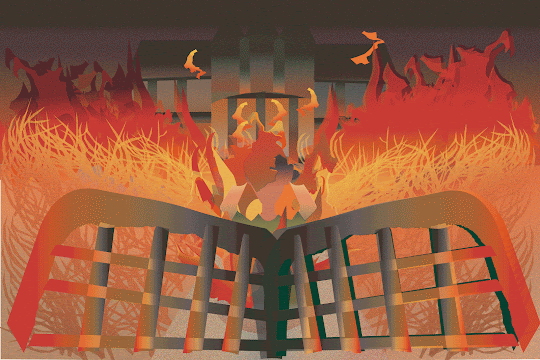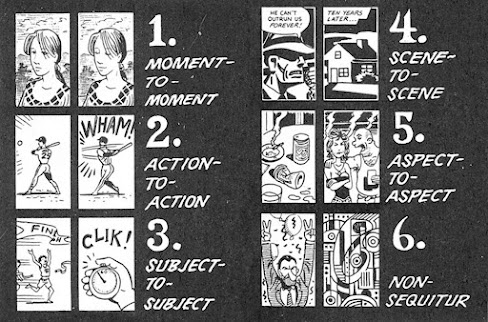ILLUSTRATION AND VISUAL NARRATIVE - ASSIGNMENT 1: EDITORIAL ILLUSTRATION (DECISIVE MOMENT)
2023.10.30 - 2023.11.20 / Week 6 - Week 9
Khan Saif / 0367438
Illustration and Visual Narrative / Bachelor of Design (Honors) in Creative Media / Taylor's University
Lecture:
Composition Theory 1: Visual Types and Shots
Visuals should be capture on:
1. Visual Narrative:
Scenes that compliment the subject focus to improve the importance of the narrative.
2. Visual Flow:
Scene that has clear flow that directs the viewers' eyes.
3. Visual Balance:
Artists can arrange the visual balance and shots to create a path for viewers' eyes.
4. Visual Hierarchy:
Visualize and focus the subject matters can have huge effects on the composition the artists make.
Different types of shots:
1. Establishing:
Wide shots that not only display the setting, but also portray spectacle and give audiences a chance to gather information for the setting and location.
2. Bird's Eyeview:
Also known as "overhead shots", the point is placed above the subject.
3. Frame within the Frame:
Shots that capture the fracture screen that also add depth to the cinematic composition.
4. Medium Shot:
Also known as "three-quarter shot", the shots frames three quarters of the character in between long shot and close-up.
5. Close-Up:
The shot display a closer shot of a character, which is essential to display emotions and smaller but attractive details of a character.
6. Worm's Eye View:
A shot display directly below the subject.
Composition Theory 2: Perspectives
1. One Point Perspective:
A single vanishing point that establishes the guideline to create three dimensional objects.
2. Two Point Perspective:
Two vanishing points that placed on both sides of the horizons to create a greater sense of space, dimension and place.
3. Three Point Perspective:
Consists of two vanishing points on the horizons, with another one places either above or below the horizon to form a somewhat triangular perspective.
4. Isometric View:
For creating detailed concepts of individual buildings, it's more beneficial to use a simple isometric view, since it allows to clearly show the three sides of the design without any obscuring details or distorting perspective.
Composition Theory 3: Fore, Mid and Background
When composing the scene, creating an effective space is an important aspect.
1. Foreground:
Objects that are nearest to the viewers. Use size difference and color contrast to highlight the main focus.
2. Middle-ground:
Objects that are between the foreground and background. Use size difference and light/shadow contrast to highlight the main focus.
3. Background:
Objects that are furthest to the viewers. Use shapes and light/shadow contrast to highlight the main focus.
4. Visual Flow
Good arrangement of visual focus using foreground, middle-ground and background should indicate a sense of movement and rhythm. A design with good flow also leads viewers' eyes throughout the layout.
Assignment: Editorial Illustration
For this project, we were tasked to illustrate a composition based on an urban legend stories with an Art Deco style.
Originally, I was thinking of doing area 51, since this has been a discussion for years, where there was a debate whether a group of military had experimented extraterrestrial lives. But I'd reconsider another legend, since science doesn't really fit Art Deco art style for my taste.
So, I decided to chose something a bit gothic, disastrous. The tale of Seven Gates of Hell has caught my attention not only during the project, but also lately. There was once a mental asylum near Pennsylvania that was burned down, along with refugees and staff members in the asylum, before the firemen could come to the rescue. However, since then, some theorists spread conspiracies surrounding one of the gates in the burnt asylum. It was said that 7 gates will appear at night, including the only one in daytime, and each of them will display the trespassers the visions of hell. However, the conspiracies remain unconcluded, and whoever takes one step of the burnt property will be consider trespassing.
Here's the full summary I've put in pieces with the references below:
Located in York County, Pennsylvania sits the Hellam Township, population hovering around six thousand but on the outskirts, there is a road formerly known as Toad Road which is said to be the starting point to find the gates of hell.
During the 1800s a large mental asylum was constructed along Toad Road, far enough away from the towns where everyone felt safe and hidden in the remote woods so as to not be an eyesore.
The worst of the worst were brought and kept at the asylum, murderers, rapists, and other deranged human beings. But towards the end of the 1800s disaster struck; a fire broke out in the asylum. No one knows how it started but it spread quickly, igniting the upper floors and burning everything and everyone in its path.
Because of the remoteness of the asylum, firefighters couldn’t reach it in time to save the asylum. Many patients on the third and fourth floors burned to death but others… escaped. Police and others created a perimeter around the fiery ashes of the asylum intending to capture any escapees peacefully but many resorted to violent methods.
Stories tell of the insane patients attacking those looking for them and in turn, the searchers became hunters, finding, beating, and killing the patients to prevent them from reaching the town. Eventually, with the number of patients on the loose, the police decided to close them in, building iron gates as they searched.
Seven gates were built surrounding the remains of the asylum. At every gate with the distance closing in, the police found more of the escaped patients, capturing the peaceful but killing any that showed aggression in violent ways.
Legend says the anger, hate, and violence in these souls caused a rift that allowed for Hell to open, the gates preventing anything to be let out but also preventing anyone from traveling in.
References:
This is my final illustration. Once again, it is based on the story how the Seven Gates of Hell conspiracy came to be. Of course, I applied the artwork with some visual techniques and compositions based on from what I've learnt from the lecture.
I did add some elements for visual narrative for this illustration. Despair is the main theme for visual narrative, as a wrathful man behind the gate slowly burnt to fire, witnessing what is in the depths the hell just by being inside the gate. The fire that were about to burnt the asylum to crisp the grasses swept within is the depths of visual flow. The goal of the visual shots is not only showcased the visual balance, but also the wide, establishing shot to gather the setting and location loud and clear, There's also an attempt of executing one point perspective by putting the vanishing point at the center of the artwork, as demonstrated the road between grasses. Not to mention, there's also an attempt of subtle frame within a frame, thanks to the tree woods that sit attached to the gates.
Reflection: (Improvement)
While I think this artwork can be impressive at first glance due to the details, but as I stared at the artwork further and I think this artwork needs some improvement in a sense. Sometimes I couldn't help find myself complicate things just by adding more to further complicate things, due to the amount of details in the artwork.
Here's the thing I should improve on: There should have a better focus and visual flow on fire rather than the grass. The grass in the artwork is too large that they even sometimes block out the fire. As stated in the lecture, if you want movement that sticks to the viewers' eyes, be sure to visualize them in foreground, middle-ground and the background of the artwork, and this artwork seemed to fail to do so in my opinion. Thankfully, the limited animation project next week can fix the fire's out of focus by letting the fire slowly, gradually burnt all the way to the despaired man, and eventually most of the space of the artwork behind the gates attached to the woods.
On top of that, the man lying down burning should be a better focus as well, as the gates are too big for him to become a better focus.
Final Animation:
Back to the drawing board, Mr. Hafiz gave me permission to adjust the artwork as much as possible. I want to adjust the artwork piece as much as possible in order to make the artwork look more intense as the concept itself.
Final Artwork:
Animation:
Frame 2:
Frame 4:
Final Animation:
List of Scott McCloud's Transitions:
1. Moment to Moment:
A single action portrayed in a series of moments.
2. Action to Action:
A single subject (person, object...) in a series of actions.
3. Subject to Subject:
A series of changing subjects within a single scene.
4. Scene to Scene:
Transitions across significant times/spaces/distance.
5. Aspect to Aspect:
Transitions from one aspect of a place, idea or mood etc.
6. Non-sequitur:
Latin's defintion of "not following", a series that is seemingly non-sensical or related images and words.
Project 2 Transition:
Sketch:
Concept Transitions:
Rationale:
My sketch above displayed the transition of subject to subject. The first scene displayed a close up of a man witnessed a fire near the mansion, followed by the artwork displayed with 2 gates opening by, with flames surrounding by the mansion, followed again by displaying the entire forest was burned, leaving only the mansion's gate, foreshadowing what this gate in Pennsylvania has yet to come.
Feedback:
Mr. Hafiz suggested the first transition displaying the close-up shot of the gate, rather than the man in the artwork, as the gate is supposed to be the main focus of the artworks and transitions.
Final Transition Artwork:
.jpg)








.png)




Comments
Post a Comment